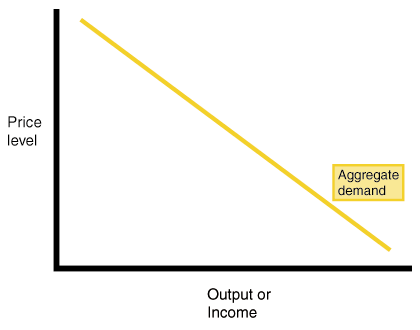Notes (2/11/15) - AGGREGATE DEMAND
- shows the amount of real GDP that the private, public, and foreign sectors collectively desire to purchase at each possible price level
- the relationship between the price level and the level of real GDP is inverse

- Three reasons AD is downward sloping:
- (1) Real-balance effects
- when price-level is high households and businesses cannot afford to purchase as much output
- when price-level is low households and businesses can afford to purchase more output
- (2) Interest-rate effects
- higher price-level increases the interest rate which tends to discourage investment
- lower price-level decreases the interest rate which tends to encourage investment
- (3) Foreign-purchase effect
- higher price-level increases the demand for relatively cheaper imports
- lower price-level increases the foreign demand for relatively cheaper U.S. exports
Shifts In AD
- two parts to a shift in AD:
- (1) change in C, Ig, G, and/or Xn
- (2) multiplier effect that produces a greater change than the original change in the four components
- Increases in AD = AD shifts right
- Decreases in AD = AD shifts left
- Increase:
- Decrease:
Consumption
- Household spending affected by:
- consumer wealth
- more wealth = more spending (AD shifts right)
- less wealth = less spending (AD shifts left)
- consumer expectation
- positive expectation = more spending (AD shifts right)
- negative expectation = less spending (AD shifts left)
- household indebtedness
- less debt = more spending (AD shifts right)
- more debt = less spending (AD shifts left)
- taxes
- less taxes = more spending (AD shifts right)
- more taxes = less spending (AD shifts left)
Gross Private Domestic Investment
- Investment spending is sensitive to:
- Real-interest rate
- lower real interest rate = more investment (AD shifts right)
- higher real interest rate = less investment (AD shifts left)
- Expected returns
- higher expected return = more investment (AD shift right)
- lower expected return = less investment (AD shifts left)
- influenced by
- (1) expectations of future probability
- (2) technology
- (3) degree of excess capacity (existing stock of capital)
- (4) business taxes
- More government spending (AD shift right)
- Less government spending (AD shift left)
Net Exports
- sensitive to:
- Exchange rate (international value of %)
- strong $ = more imports & fewer exports (AD shift left)
- weak $ = less imports &more exports (AD shift right)
- Relative income
- strong foreign economies = more exports (AD shift right)
- weal foreign economies = less exports (AD shift left)


I really love how you went about typing your notes. It's very organized and I love how you went really in depth with explaining the three reasons why aggregate demand is downward slopping. Keep up the great work!
ReplyDelete